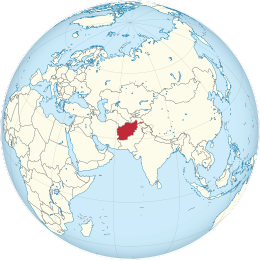공용:지역별 저작권 법규/아프가니스탄
|
저작권 법규: 아프가니스탄 단축: COM:아프가니스탄 | |
 | |
 | |
| 보호기간 | |
|---|---|
| 일반저작물 | 사후 50년 (아프가니스탄 달력 기준) |
| 사진저작물 | 공표 후 50년 |
| 익명의 저작물 | 공표 후 50년 |
| 영상저작물 | 공표 후 50년 |
| 사후에 공표된 저작물 | 공표 후 50년 |
| 기타 | |
| 파노라마의 자유 | No |
| 공용 라이선스 틀 |
{{PD-old-auto}} {{PD-Afghanistan}} |
| 국제 협약 | |
| 베른 협약 | 2018년 6월 2일 |
| 세계 무역 기구 | 2016년 7월 29일 |
| URAA 회복일 [1] | 2016년 7월 29일 |
| WIPO 조약 | 2021년 2월 9일 |
| [1]A work is usually protected in the US if it is a type of work copyrightable in the US, published after 31 December 1928 and protected in the country of origin on the URAA date. | |
이 문서는 위키미디어 공용에 작업물을 업로드하는 것과 관련해서 아프가니스탄의 저작권 법규의 개괄을 다룹니다. 아프가니스탄에서 나온 모든 저작물은 공용에 업로드하기 위해서는 아프가니스탄과 미국 양쪽 모두에서 퍼블릭 도메인이거나 자유 라이선스로 이용 가능해야 합니다. 아프가니스탄에서 나온 저작물의 저작권 상태에 대해 어떠한 의심이 가는 경우 명확히 하기 위하여 관련 법률을 참조하시기 바랍니다.
배경
아프가니스탄은 19세기 후반, 영국의 느슨한 통제 하에 들어갔습니다. 1919년 있었던 3차 앵글로-아프간 전쟁 후 아프가니스탄은 다시 독립을 쟁취하였습니다. 그러나 이후로 아프가니스탄은 반란, 침략, 내전에 휩싸였습니다.
아프가니스탄은 2016년 7월 29일 세계무역기구, 2018년 6월 2일에는 베른 협약, 2021년 2월 9일에는 WIPO 저작권 조약에 가입하였습니다.[1]
2018년 기준, UN 소속 기구인 세계지적소유권기구는 아프가니스탄의 저작권법(Law Supporting the Rights of Authors, Composers, Artists and Researchers)을 아프가니스탄 입법부가 제정한 주요 IP 법으로 2008년 등재하였습니다.[1] WIPO는 WIPO Lex 데이터베이스에 이 법률의 내용을 보유하고 있습니다.[2]
The Taliban government since 2021 is unrecognized, but continues to enforce existing copyright law.
보호 기간
Under the 2008 Copyright Law, protection is as follows:
- Works published or broadcast during the life cycle of the author shall be protected 50 calendar years after his/her death unless the author has decided differently.[2008 Article 16.1.1]
- Joint works published or broadcast during the life cycle of the authors shall be protected for 50 years after the death of the last author.[2008 Article 16.1.2]
- Works published or broadcast with metaphorical (pseudonym) names shall be protected for 50 years after the first year of the publication.[2008 Article 16.1.3]
- Works not published during the life cycle of the author and in the case of the joint work, that have not been published during the life cycle of the last author, shall be protected for 50 years effective from the first year of publication and broadcast.[2008 Article 16.1.4]
- Audiovisual works shall be protected for 50 years effective from the first year of the publication or broadcast.[2008 Article 16.1.5] If the work is not published or broadcast, it shall be protected for 50 years from fixation.[2008 Article 16.2]
- Photography and painting works shall be protected 50 years effective from the first year of publication and broadcast.[2008 Article 16.1.6]
Folklore
Public Culture (National Folklore) is an expression which include characterized principles of traditional artistic heritage originated or developed by a group of people in the State which reflect their artistic heritage and include the following expressions: Oral expressions such as tales, popular poetry and riddles; Musical expressions: include popular songs accompanied by music or without music; Motion expressions, include popular Atans (national dance), plays and other special popular artistic and ritual forms; Identical expressions such as products or popular art such as drawings with lines and colors, engravings, statuary, pottery, needlework, woodwork, mosaic, metalwork, jewelry, knitting, carpet weaving and other textiles; Musical instruments; Different architectural works.[2008 Article 3.23]
National folklore shall be the public property of the State, the Ministry of Information and Culture, shall protect National Folklore by all legal means.[2008 Article 45]
Copyright tags
참조: 공용:저작권 틀
- {{PD-Afghanistan}} – public domain (no existing copyright law)
Freedom of panorama
참조: Commons:파노라마의 자유
![]() 괜찮지 않음. The 2008 Law Supporting the Rights of Authors, Composers, Artists and Researchers (Copyright Law) does not contain a freedom of panorama provision. None of the exceptions under Articles 39–44 contain a provision allowing free uses of images of architectural and artistic works that can be found in public spaces.
괜찮지 않음. The 2008 Law Supporting the Rights of Authors, Composers, Artists and Researchers (Copyright Law) does not contain a freedom of panorama provision. None of the exceptions under Articles 39–44 contain a provision allowing free uses of images of architectural and artistic works that can be found in public spaces.
Article 39 permits reproductions of published works "for personal use only". Article 40 only allows noncommercial uses of extracts of works for teaching purposes. Article 42 is a close provision that allows "the press or other information media" to publish "works displayed openly to the public, provided that the name of the author is clearly indicated," but the types of works are restricted to "speeches, lectures, as well as legal proceedings or similar works," not architectural works or statuaries.
Threshold of originality
참조: 공용:창작성의 기준
According to the 2008 Copyright Law, work that may be protected includes: Photography work that has been created using an innovative mode; Innovative work of handicraft or industrial art (carpet designs, rugs, felt carpet and its attachments etc.); Innovative work which has been created based on the public culture (folklore) or national cultural heritage and art.[2008 Article 6(1) items 7-9]
Stamps
참조: Commons:Stamps
![]() Copyright expires 50 years after first put in circulation.[2008 Article 16.1.6]. For stamps published more than 50 years ago (before 1 January 1974) use {{PD-Afghanistan}}.
Copyright expires 50 years after first put in circulation.[2008 Article 16.1.6]. For stamps published more than 50 years ago (before 1 January 1974) use {{PD-Afghanistan}}.
See also
Citations
- ↑ a b Afghanistan Copyright and Related Rights (Neighboring Rights). WIPO: World Intellectual Property Organization (2018). Retrieved on 2018-11-08.
- ↑ Law Supporting the Rights of Authors, Composers, Artists and Researchers (Copyright Law). Afghanistan (2008). Retrieved on 2018-11-08.